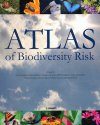Atlas
Out of Print
Edited By: Joseph Settele
264 pages, Col photos, col illus, maps
![Atlas of Biodiversity Risk Atlas of Biodiversity Risk]()
Click to have a closer look
About this book
Contents
Related titles
About this book
The first atlas of its kind to describe and summarise in a comprehensive, easy-to-read and richly illustrated form the major pressures, impacts and risks of biodiversity loss at a global level. The main risks identified are caused by global climate and land use change, environmental pollution, loss of pollinators and biological invasions. The impacts and consequences of biodiversity loss are analyzed with a strong focus on socio-economic drivers and their effects on society. Three scenarios of potential futures are the baseline for predicting impacts and explore options for mitigating adverse effects at several spatio-temporal scales. Elements of these futures are modeled, tested and illustrated.
The Atlas is divided into chapters which mostly deal with particular pressures. It furthermore is based on case studies from a large set of countries, which are completed by introductory and concluding texts for each chapter. The Atlas combines the main outcomes of the large European project ALARM (performed by 68 partner organisations from 35 countries from Europe as well as other continents) with some core outputs of numerous further research networks. A total number of 366 authors from more than 180 institutions in 43 countries provided information and contributed to the Atlas.
The Atlas is addressed to a wide spectrum of users. Scientists will find summaries of well-described methods, approaches and case studies. Conservationists and policy makers will use the conclusions and recommendations based on academic research output and presented in a comprehensive and easy-to-read way. Lecturers and teachers will find good examples to illustrate the main challenges in our century of global environmental changes. The Atlas is an indispensible tool to any library or institution in biodiversity and environmental sciences. Finally, all people concerned with environmental issues will find the Atlas a powerful weapon in their fight for saving the life on our Planet!
Contents
Preface
Introduction
List of contributors
Chapter 1. BIODIVERSITY BASELINE INFORMATION
Chapter 2. RESEARCH APPROACHES FOR BIODIVERSITY AND IMPACTING FACTORS
Chapter 3. CLIMATE CHANGE IMPACTS ON BIODIVERSITY
Chapter 4. LAND USE CHANGES AND THEIR IMPACTS
Chapter 5. ENVIRONMENTAL CHEMICALS AND BIODIVERSITY
Chapter 6. BIOLOGICAL INVASIONS
Chapter 7. DECLINE OF POLLINATORS AND ITS IMPACT
Chapter 8. SOCIO-ECONOMY AND ITS ROLE IN BIODIVERSITY LOSS
Chapter 9. COMBINED BIODIVERSITY EFFECTS OF MAJOR DRIVERS AND PRESSURES
Chapter 10. THE FUTURE OF BIODIVERSITY AND BIODIVERSITY RESEARCH
Customer Reviews
Atlas
Out of Print
Edited By: Joseph Settele
264 pages, Col photos, col illus, maps






































